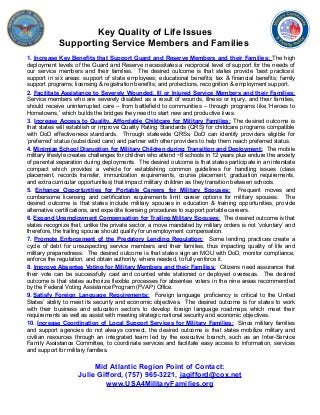
Key Quality Of Life Issues Supporting Service Members And Families (12 10 08)
- 1. Key Quality of Life Issues Supporting Service Members and Families 1. Increase Key Benefits that Support Guard and Reserve Members and their Families: The high deployment levels of the Guard and Reserve necessitates a reciprocal level of support for the needs of our service members and their families. The desired outcome is that states provide ‘best practices’ support in six areas: support of state employees; educational benefits; tax & financial benefits; family support programs; licensing & registration benefits; and protections, recognition & employment support. 2. Facilitate Assistance to Severely Wounded, Ill or Injured Service Members and their Families: Service members who are severely disabled as a result of wounds, illness or injury, and their families, should receive uninterrupted care – from battlefield to communities – through programs like ‘Heroes to Hometowns,’ which builds the bridges they need to start new and productive lives. 3. Increase Access to Quality, Affordable Childcare for Military Families: The desired outcome is that states will establish or improve Quality Rating Standards (QRS) for childcare programs compatible with DoD effectiveness standards. Through statewide QRSs, DoD can identify providers eligible for ‘preferred’ status (subsidized care) and partner with other providers to help them reach preferred status. 4. Minimize School Disruption for Military Children during Transition and Deployment: The mobile military lifestyle creates challenges for children who attend ~8 schools in 12 years plus endure the anxiety of parental separation during deployments. The desired outcome is that states participate in an interstate compact which provides a vehicle for establishing common guidelines for handling issues (class placement, records transfer, immunization requirements, course placement, graduation requirements, and extra curricular opportunities) that impact military children as they transition between schools. 5. Enhance Opportunities for Portable Careers for Military Spouses: Frequent moves and cumbersome licensing and certification requirements limit career options for military spouses. The desired outcome is that states include military spouses in education & training opportunities, provide alternative certifications, and expedite licensing procedures to support portable careers. 6. Expand Unemployment Compensation for Trailing Military Spouses: The desired outcome is that states recognize that, unlike the private sector, a move mandated by military orders is not ‘voluntary’ and therefore, the trailing spouse should qualify for unemployment compensation. 7. Promote Enforcement of the Predatory Lending Regulation: Some lending practices create a cycle of debt for unsuspecting service members and their families, thus impacting quality of life and military preparedness. The desired outcome is that states sign an MOU with DoD, monitor compliance, enforce the regulation, and obtain authority, where needed, to fully enforce it. 8. Improve Absentee Voting for Military Members and their Families: Citizens need assurance that their vote can be successfully cast and counted while stationed or deployed overseas. The desired outcome is that states authorize flexible processes for absentee voters in the nine areas recommended by the Federal Voting Assistance Program (FVAP) Office. 9. Satisfy Foreign Language Requirements: Foreign language proficiency is critical to the United States’ ability to meet its security and economic objectives. The desired outcome is for states to work with their business and education sectors to develop foreign language roadmaps which meet their requirements as well as assist with meeting strategic national security and economic objectives. 10. Increase Coordination of Local Support Services for Military Families: Since military families and support agencies do not always connect, the desired outcome is that states mobilize military and civilian resources through an integrated team led by the executive branch, such as an Inter-Service Family Assistance Committee, to coordinate services and facilitate easy access to information, services and support for military families. Mid Atlantic Region Point of Contact: Julie Gifford, (757) 965-3221, jagifford@cox.net www.USA4MilitaryFamilies.org
